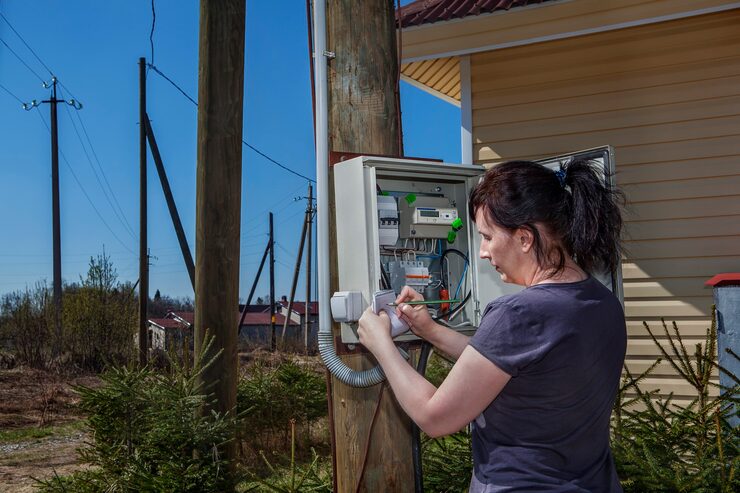How to protect your home from electrical surges in Ontario starts with recognizing the real threat power fluctuations pose to your valuable electronics and appliances. Every year, Ontario homeowners face unexpected damage from electrical surges caused by lightning strikes, utility grid switching, and faulty wiring. Understanding what causes a power surge and recognizing the signs of power surge in home environments can save thousands in repair costs.
Installing a whole house surge protector provides comprehensive defense, while knowing who pays for power surge damage helps you navigate insurance claims effectively. This guide explores everything from selecting the right power surge protector and understanding the pros and cons of whole house surge protector systems to professional whole house surge protector installation. We’ll also discuss whole home surge protector Canada options specifically suited for Ontario’s electrical infrastructure, ensuring you make informed decisions to protect home from electrical surges in Ontario.
Understanding Electrical Surges and Their Impact
Electrical surges represent sudden increases in voltage that exceed the standard 120 volts flowing through Ontario homes. These voltage spikes, lasting mere milliseconds, can wreak havoc on sensitive electronics, shortening their lifespan or causing immediate failure. Modern households contain numerous vulnerable devices including computers, smart home systems, entertainment centers, kitchen appliances, and HVAC equipment—all susceptible to surge damage.
The financial impact extends beyond replacing damaged items. According to recent industry data, the average homeowner experiences multiple surge events annually, with major surges causing damage ranging from $500 to $15,000 per incident. Ontario’s varying weather patterns, aging electrical infrastructure, and increasing reliance on electronic devices make surge protection not just advisable but essential for property preservation.
What Causes Power Surges in Ontario Homes
What causes a power surge falls into several distinct categories, each presenting unique risks to Ontario residents. Lightning strikes remain the most dramatic cause, with a single bolt carrying millions of volts that can travel through power lines and overwhelm home electrical systems. Even strikes occurring several kilometers away can induce dangerous voltage spikes through ground currents and electromagnetic fields.
Utility company operations contribute significantly to surge occurrences. When power companies switch grids, restore service after outages, or perform maintenance on transformers and substations, voltage fluctuations ripple through the distribution network. These operational surges happen more frequently than many homeowners realize, particularly during peak demand periods in summer and winter.
Internal sources pose constant threats within your walls. Large appliances cycling on and off—refrigerators, air conditioners, furnaces, and washing machines—create small surges that accumulate damage over time. Faulty wiring, loose connections, and outdated electrical panels amplify these internal disturbances. Additionally, damaged power lines from storms, vehicle accidents, or wildlife interference can send unpredictable voltage spikes directly into neighborhood electrical systems.

Recognizing the Warning Signs
Early detection of surge activity can prevent catastrophic damage and costly repairs. The signs of power surge in home environments often manifest subtly before major failures occur, making vigilance crucial for Ontario homeowners seeking to protect their investments.
Visible Indicators of Surge Damage
Your electronics and appliances provide clear signals when experiencing surge stress. Flickering or dimming lights, particularly when large appliances activate, indicate voltage instability requiring immediate attention. Devices that reset unexpectedly, display error messages, or exhibit erratic behavior may have suffered internal component damage from repeated minor surges.
Physical evidence appears on outlets and electrical fixtures. Burn marks, discoloration around receptacles, or a persistent burning smell near electrical panels suggest dangerous surge activity or wiring problems. Tripped circuit breakers and blown fuses occurring frequently, especially during storms or when specific appliances operate, point to surge issues needing professional evaluation.
Performance Degradation Patterns
Electronics suffering surge damage often display progressive performance decline. Computers running slower, crashing frequently, or requiring more restarts than usual may have compromised circuits. Television picture quality degrading, smart devices disconnecting randomly, or appliances making unusual noises indicate internal damage from voltage spikes.
Battery-powered devices charging inconsistently or batteries failing prematurely suggest surge problems affecting charging circuits. When multiple unrelated devices experience simultaneous issues, especially after storms or power outages, surge damage becomes the likely culprit rather than individual equipment failure.
Comprehensive Surge Protection Solutions
Protecting Ontario homes requires layered defense combining multiple protection strategies. While individual plug-in surge suppressors offer localized protection, comprehensive home safety demands whole house surge protector installation at your electrical service entrance.
Whole House Surge Protector Benefits
Installing a whole home surge protector Canada system provides primary defense by intercepting surges before they enter your home’s electrical system. These devices mount directly at your main electrical panel or meter, clamping voltage spikes and diverting excess energy safely to ground. Quality whole-house protectors handle surges up to 40,000 amperes or more, significantly exceeding the capacity of individual plug-in devices.
The coverage extends to all circuits simultaneously, protecting hardwired appliances, HVAC systems, built-in electronics, and every outlet throughout your residence. This comprehensive approach particularly benefits Ontario homes with valuable smart home systems, home offices, entertainment rooms, and extensive kitchen appliances requiring consistent power quality.
Installation at the service entrance also protects against surges originating both externally from utility lines and internally from large appliance operation. This dual protection capability makes whole-house systems far superior to relying solely on point-of-use devices, which only protect individual outlets and offer no defense for hardwired equipment.
Evaluating Pros and Cons
Understanding the pros and cons of whole house surge protector systems helps Ontario homeowners make informed investment decisions. The advantages include comprehensive protection for all household circuits, higher surge capacity than plug-in models, protection for hardwired appliances and systems, increased property value, and reduced insurance claims for electrical damage.
Long-term cost savings prove substantial. While initial installation requires investment, preventing even one major surge event typically offsets the entire cost. Protected appliances last longer, perform more reliably, and maintain optimal energy efficiency without degradation from repeated minor surges.
The disadvantages center primarily on upfront costs and installation requirements. Professional whole house surge protector installation typically ranges from $300 to $800 in Ontario, depending on panel complexity and protector specifications. The process requires licensed electrician services and potential electrical panel upgrades for older homes lacking adequate capacity or proper grounding.
Whole-house protectors also require periodic maintenance and eventual replacement, typically every 5-10 years depending on surge exposure. However, most quality units include indicator lights showing operational status, making maintenance monitoring straightforward. Despite these considerations, the overwhelming consensus among electrical safety experts positions whole-house protection as essential rather than optional for modern Ontario homes.
Professional Installation Considerations
Whole house surge protector installation demands professional expertise ensuring proper connection, adequate grounding, and code compliance. Ontario’s Electrical Safety Authority regulations require licensed electricians to perform installations, guaranteeing work meets safety standards while protecting your insurance coverage validity.
Selecting Qualified Installation Services
Choosing the right electrician involves verifying licensing through the Electrical Safety Authority of Ontario, checking insurance coverage for liability protection, and reviewing experience specifically with surge protection systems. Request references from recent whole-house protector installations and inquire about warranty offerings on both equipment and labor.
Quality installers assess your existing electrical panel capacity, grounding system adequacy, and overall wiring condition before recommending specific protector models. They should explain surge ratings measured in joules, clamping voltage specifications, and response times ensuring adequate protection for your household’s electronic load.
Installation Process and Timeline
Professional installation typically completes within two to four hours, depending on panel accessibility and necessary upgrades. The electrician begins by evaluating your main service panel, confirming adequate space for the surge protector unit, and testing the grounding system effectiveness.
The actual installation involves temporarily disconnecting main power, mounting the surge protector adjacent to your electrical panel, connecting it properly to main service conductors, ensuring solid grounding connections, and restoring power while verifying correct operation through indicator lights or displays.
Many Ontario electricians recommend complementing whole-house protection with quality point-of-use surge suppressors for sensitive electronics like computers and entertainment systems. This layered approach provides maximum protection by combining the whole-house unit’s high capacity with fine-tuned secondary protection at vulnerable equipment locations.

Understanding Financial Responsibility
Determining who pays for power surge damage involves complex interactions between homeowner insurance, utility company liability, and specific surge circumstances. Ontario homeowners must understand coverage parameters to ensure adequate protection and successful claims processing when damage occurs.
Insurance Coverage Parameters
Most Ontario homeowner insurance policies cover power surge damage as a named peril, but coverage limitations and exclusions apply. Standard policies typically protect electronics, appliances, and wiring damaged by sudden surges from external sources like lightning strikes or utility grid problems. However, coverage amounts vary significantly, with many policies capping electronics coverage between $5,000 and $15,000 unless additional riders provide enhanced protection.
Deductibles apply to surge damage claims just as with other covered perils. If your deductible exceeds the damage cost, filing claims becomes financially disadvantageous. Review your policy carefully, noting specific exclusions for gradual damage from repeated minor surges or damage resulting from lack of maintenance and outdated wiring.
Utility Company Liability
Ontario utility companies rarely accept liability for surge damage unless clear negligence proves responsible for the voltage spike. Proving utility fault requires demonstrating the surge originated from company equipment failure, improper maintenance, or operational errors—burdens of proof that prove difficult for individual homeowners.
Most utility service agreements explicitly limit liability for consequential damages resulting from power quality issues. However, documenting surge events through surge protectors with data logging capabilities, maintaining records of reported power quality problems, and photographing damage immediately after occurrences strengthens potential claims should utility negligence become apparent.
Advanced Protection Strategies
Beyond basic whole-house surge protection, implementing comprehensive strategies maximizes safety and minimizes risk. Ontario’s climate and electrical infrastructure present unique challenges requiring tailored approaches for optimal home protection.
Layered Defense Systems
Combining whole-house protection with strategic point-of-use devices creates robust layered defense. Install Type 1 surge protectors at your main service entrance as primary protection, Type 2 protectors at subpanels or major circuits feeding specific areas, and Type 3 point-of-use suppressors at outlets serving sensitive equipment.
This cascading protection approach ensures each layer handles progressively smaller surges, with primary units stopping massive external surges and secondary devices filtering residual voltage fluctuations. High-value electronics benefit most from this strategy, particularly home theaters, computer systems, medical equipment, and smart home hubs.
Grounding System Optimization
Surge protectors depend entirely on effective grounding to divert excess voltage safely. Ontario homes, particularly older construction, may have inadequate grounding systems compromising surge protection effectiveness. Professional electricians should verify ground resistance measures below 25 ohms, ideally under 10 ohms for optimal surge dissipation.
Upgrading grounding involves installing additional ground rods, connecting to metal water pipes where permitted by code, and ensuring all ground connections remain tight and corrosion-free. Regular grounding system inspections, especially after major storms or construction work, maintain protection integrity throughout your surge defense network.
Smart Monitoring Technology
Modern surge protectors incorporate smart technology enabling remote monitoring, surge event logging, and automatic notifications when protection capacity depletes. These advanced features let Ontario homeowners track power quality, identify recurring surge patterns, and schedule proactive replacements before protection fails.
Integration with home automation systems provides centralized control and monitoring, automatically shutting down sensitive equipment during severe weather or documented surge events. While representing higher initial investment, smart surge protection offers peace of mind and documented evidence supporting insurance claims when damage occurs.
Selecting the Right Protection for Ontario Homes
Choosing appropriate whole home surge protector Canada systems requires understanding technical specifications, climate considerations, and household electrical demands. Ontario’s electrical infrastructure and weather patterns influence optimal protection strategies.
Technical Specifications Explained
Surge protectors carry ratings indicating protective capacity and performance characteristics. Joule ratings measure total energy absorption capacity, with whole-house units typically ranging from 20,000 to 80,000 joules or more. Higher ratings provide longer protection lifespan and handle multiple surge events before requiring replacement.
Clamping voltage determines when protection activates and how much voltage reaches protected circuits. Lower clamping voltages—typically 330V to 400V for whole-house units—provide tighter protection but may activate more frequently. Response time measured in nanoseconds indicates how quickly protection engages, with faster responses under one nanosecond providing superior defense for sensitive electronics.
Climate and Environmental Factors
Ontario’s diverse weather presents unique surge protection challenges. Areas experiencing frequent thunderstorms, including regions near the Great Lakes, require higher-capacity protection accounting for increased lightning strike probability. Urban areas with dense power infrastructure may experience more utility-related surges from grid switching and heavy industrial loads.
Rural Ontario properties often face greater surge risks from longer power lines, reduced infrastructure redundancy, and wildlife interference with electrical equipment. These locations benefit from maximum-capacity whole-house protectors combined with backup power systems preventing damage from extended outages and subsequent power restoration surges.

Maintenance and Longevity
Surge protectors require ongoing maintenance ensuring continued protection effectiveness. Unlike passive electrical components, surge protection devices gradually wear with each intercepted surge, eventually requiring replacement to maintain home safety.
Monitoring Protection Status
Quality whole-house surge protectors include visual indicators showing operational status. LED lights typically display green for active protection, yellow for reduced capacity, and red for failed protection requiring immediate replacement. Check these indicators monthly, especially after severe storms or power outages potentially causing surge activity.
Advanced units provide detailed status information through digital displays or smartphone apps, tracking captured surge events, remaining capacity, and protection health metrics. These monitoring capabilities enable proactive replacement before protection fails, maintaining continuous home defense against electrical surges.
Replacement Schedules and Upgrades
Whole-house surge protectors typically last five to ten years under normal conditions, with lifespan depending on surge frequency and intensity. Properties experiencing frequent storms, power quality issues, or major surge events require more frequent replacement. Follow manufacturer recommendations for maximum service life even when indicators suggest continued operation.
Technology advances warrant periodic upgrades beyond simple replacement. Modern surge protectors offer superior specifications, smart monitoring features, and enhanced protection compared to units installed even five years prior. Consult with licensed electricians during routine electrical inspections to evaluate current protection adequacy and consider beneficial upgrades.
Frequently Asked Questions
How much does whole house surge protector installation cost in Ontario?
Professional whole house surge protector installation in Ontario typically ranges between $300 and $800, including both equipment and labor. Basic units with standard protection capacity cost less, while premium models featuring higher joule ratings, lower clamping voltages, and smart monitoring capabilities command higher prices. The total investment depends on your existing electrical panel configuration, necessary upgrades for proper installation, and specific protector specifications. Most licensed electricians provide free estimates after evaluating your home’s electrical system, allowing accurate budgeting before committing to installation.
Can I install a whole house surge protector myself?
Installing whole house surge protectors requires licensed electrician services in Ontario due to Electrical Safety Authority regulations and insurance requirements. DIY installation violates electrical codes, voids equipment warranties, compromises insurance coverage, and creates serious safety hazards including electrocution risk and fire danger. Professional installation ensures proper connection to main service conductors, adequate grounding for effective surge dissipation, compliance with current electrical codes, and valid permits maintaining your home’s insurability and resale value.
Do surge protectors work against lightning strikes?
Whole house surge protectors provide significant defense against lightning-induced surges but cannot guarantee complete protection from direct strikes. These devices effectively handle indirect lightning effects—voltage spikes traveling through power lines from nearby strikes—which represent the majority of lightning-related surge damage. Direct strikes carrying millions of volts may overwhelm any protection system. However, quality whole-house protectors significantly reduce damage even from direct strikes by diverting substantial energy to ground. Combining surge protection with lightning rod systems provides comprehensive defense for Ontario properties in high-risk areas.
How do I know if my surge protector needs replacement?
Monitor indicator lights on your whole house surge protector regularly. Most units display green for active protection, transitioning to yellow or red when capacity depletes or failure occurs. Replace protectors immediately when indicators show failure or reduced capacity. Additionally, replace units after major surge events like nearby lightning strikes, every five to ten years regardless of indicator status, following manufacturer recommendations for maximum service life, and during electrical panel upgrades or major renovations. Proactive replacement before complete failure ensures continuous protection preventing costly damage from unprotected surge exposure.
Will my insurance cover power surge damage if I don’t have surge protection?
Most Ontario homeowner insurance policies cover sudden power surge damage regardless of surge protector presence, though specific terms vary significantly between insurers. However, lacking surge protection may complicate claims if insurers determine negligence contributed to damage severity. Some policies offer premium discounts for documented whole-house surge protection installation, offsetting investment costs. Review your specific policy carefully, noting coverage limits for electronics and appliances, deductibles applying to surge damage claims, and exclusions for gradual damage or maintenance-related issues. Consult your insurance provider about coverage specifics and potential premium benefits from surge protection installation.
Protecting Your Ontario Home Investment
Electrical surges represent constant threats to modern Ontario homes filled with sensitive electronics and valuable appliances. Understanding causes, recognizing warning signs, and implementing comprehensive protection through professional whole house surge protector installation provides peace of mind and financial security against unexpected damage.
The investment in quality surge protection returns value through prevented equipment damage, extended appliance lifespan, maintained home electrical system integrity, and reduced insurance claims. Ontario homeowners prioritizing electrical safety position themselves advantageously against the inevitable power quality issues affecting residential properties throughout the province.
Don’t wait for costly surge damage to motivate action. Contact licensed electricians today to evaluate your home’s surge protection needs, discuss installation options suited to your property’s electrical configuration, and implement comprehensive defense strategies protecting your valuable electronics and appliances from Ontario’s unpredictable electrical environment.
Ready to protect your home from electrical surges? Whether you’re planning a major event at your property or simply want to safeguard your everyday electronics, professional electrical safety assessments and surge protection installation provide essential peace of mind. For comprehensive event planning services in Toronto, including ensuring proper electrical protection for special occasions, visit Ontario Air Services for expe
rt guidance and professional solutions tailored to your specific needs.
Sources:




